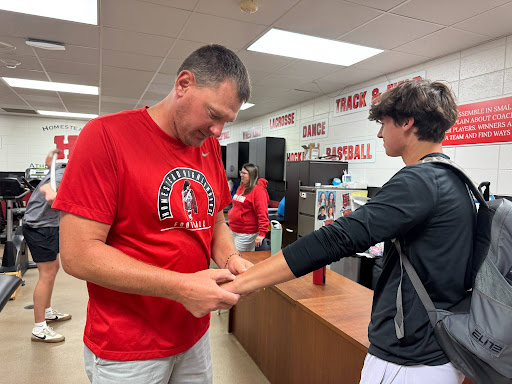Teen Stress: A growing epidemic
Insomnia.
Changes in appetite.
Overwhelming emotions.
Low energy.
Suicide.
Stress looks different in everyone, but in every school across the nation, high levels of stress can be found and the numbers are only increasing.
Ms. Danielle Kuzmanovic, school counselor, discusses how she has seen an increase in the amount of stress in students over the years.
“There is an increased pressure to be perfect. Years ago it was more common to focus on one thing and be good in one area. It’s great people are pursuing excellence in all of these areas of life, I think it’s stressful and a tough expectation to reach up to and we see it more and more”
Mrs. Terry Carr, social worker, also observes the change of stress and amount of pressure that has been placed on students.
“I think students have become more aware of stress. It is harder for students to limit what they do. They are really busy and have a lot of activities and 3 or 4 AP classes, no study halls. There is a lot of pressure.”
Mr. Joseph Przybylski, psychology and social studies teacher thinks the increase stems from the push for students to take on more challenging classes and to do exceedingly well in them, taking a toll on the students and their overall mental health.
“Our number of AP offerings has increased greatly, plus the college push, the ACT push, those things are very different than 20 years ago, much more demanding. Students are getting better counseling than earlier in the process, but students still stress out quite a bit, and I can see that in students during that time of the year when its time to get the college recommendations and essays in. There is a certain amount of stress there overall, but our counseling department has done a good job on nursing them through that,” Przybylski said.
The suggestion that students to be placed in the accelerated courses while thriving in extracurricular activities has played a part in stress levels rising in students to match those of adults.
“It is alarming that the teen stress experience is so similar to that of adults. It is even more concerning that they seem to underestimate the potential impact that stress has on their physical and mental health,” APA CEO and Executive Vice President Norman B. Anderson, PhD said.
The consequences can turn detrimental for people if they do not learn how to properly cope with the amount of pressure they are put under in a healthy way.
“The damage that happens to kids from the infectious disease of toxic stress is as severe as the damage from meningitis or polio or pertussis,” according to Dr. Tina Hahn, a pediatrician in rural Michigan.
Kuzmanovic offers advice for when students are becoming overwhelmed and simply need to take a minute to slow down and breath. It can be helpful for students to know how to deal with and lower their high levels of stress.
“Positive coping mechanisms can be pausing and taking a minute to acknowledge this is not going well and reflect to what you need in that moment like a break, a minute to go get a drink, to vent or to get a hug from your mom. It could be as simple as one thing and its important for each individual,” Kuzmanovic said.
Currently, many students are coping in unhealthy ways because they are unaware of other ways to deal with their high amount of stress. For many students their appetite and sleep are the first things to be neglected.
“Forty percent of teens report feeling irritable or angry and 36% report feeling nervous or anxious. Many teens report feeling overwhelmed (31%) and depressed or sad (30% as a result of stress. More than one-third of teens report fatigue/feeling tired (36% and having lain awake at night because of stress (35%). Nearly one-quarter of teens (23%) have skipped a meal because of stress,” the American Psychology Association reports.
When stress and other factors begin to take a toll on the minds of teenagers, mental health becomes an even bigger issue. Anxiety and depression are widely present in high schoolers, and a main catalyst of suicide.
Tom Simon, an author of the report and associate director for science in the division of violence protection at the US Centers for Disease Control and Prevention, states that “between 2007 and 2015, there’s substantial increases in suicide rates for both young males and young females.” The rate of suicides committed between 15 and 19 year olds in 2007 was 10.8 per 100,000 and increased to 14.2 per 100,000 by 2015. For women with 15-19 years of age, rate was 2.4 per 100,000 in 2007 and then spiked to 5.1 per 100,000 in 2015 (Scutti).
This problem may be nationwide, but multiple suicides of high school students in Brookfield, Wisc. make the issue hit close to home.
A 14-year-old student from Brookfield, Alexa Berman, took her own life in August, 2008, only three days before her first day of freshman year. She had written a post on instagram saying what she was planning on doing it; however, not a single person said or did anything to prevent her actions. Alexa’s parents have been working to raise awareness and and educate people on warning signs.
Berman was not the only teenager whose life was lost. Lindsey Huenink, a senior at Brookfield Central High School, committed suicide by jumping in front of a train at 3 a.m. on March 30, 2011 when she was only 18 years old. At Lindsey’s memorial service, her pastor said, “Sometimes when someone takes their own life, we feel like we really didn’t know this person. Well, let me assure you, we knew her. We perhaps didn’t know the sadness she was feeling. But that doesn’t change who Lindsey really was.”
Similar to the two girls, Malik Turner, a senior at Brookfield Central High School and a running back on the varsity football team, lost his life Jan. 19, 2016. Turner was widely known among his classmates and had a bright future ahead of him, and no one expected this tragedy.
The stress that students endure throughout their high school careers can be incredibly overwhelming, and teenagers are often not aware of the pain and struggles their peers are going through. When stress increases to a toxic level it is important for students to take control of the situation, because there are healthy way to deal with each problem.
“I think exercise and activity, whether its dance or yoga can be a good way to cope. The research on mindfulness is really interesting and can help you stay grounded in the present. Limiting social media can be helpful. Also, just taking downtime, whether that’s being alone or doing something fun with family or friends,” Carr suggests.

Anna Greisch is a Sophomore at Homestead High School and is excited to be enrolled in her first year of Publications. Outside of school, she enjoys being...

Ally Chung is a Sophomore at Homestead High School and is super excited to begin her first year of Publications. Outside of school she can be found participating...





